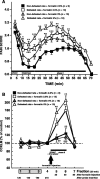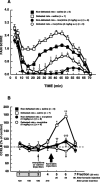Involvement of cholecystokininergic systems in anxiety-induced hyperalgesia in male rats: behavioral and biochemical studies
- PMID: 16135746
- PMCID: PMC6725462
- DOI: 10.1523/JNEUROSCI.0743-05.2005
Involvement of cholecystokininergic systems in anxiety-induced hyperalgesia in male rats: behavioral and biochemical studies
Abstract
Keeping in mind the increased pain complaints reported in anxious or depressive patients, our goal was to investigate in rats the consequences of an experimentally provoked state of anxiety/depression on pain behavior and on its underlying mechanisms. We therefore used a model of social defeat consisting of a 30 min protected confrontation followed by a 15 min physical confrontation, repeated during 4 d, that elicited symptoms close to those observed in humans with anxiety or depression. Indeed, 5 d later, animals subjected to social-defeat confrontation were characterized by a decrease of sweet-water consumption and of body weight, and a hyperactivity of the hypothalamic-pituitary-adrenal axis, suggesting that the social-defeat procedure induced a prolonged state of anxiety. Rats subjected to the social-defeat procedure showed an enhanced nociceptive behavior to the subcutaneous administration of formalin, 5 d after the last confrontation session. Because chronic treatment with the established anxiolytic chlordiazepoxide (10 mg.kg(-1).d(-1)) prevented hyperalgesia, this strongly suggested that this experimental procedure might be a suitable animal model of "anxiety-induced hyperalgesia." Hyperalgesia associated with anxiety not only was related to a significant increase of CCKLM [cholecystokinin (CCK)-like material] in frontal cortex microdialysates but also was prevented by a CCK-B receptor antagonist [4-[[2-[[3-(1H-indol-3-yl)-2-methyl-1-oxo-2[[(tricyclo[3.3[12,17]dec-2-yloxy)-carbonyl]amino]-propyl]amino]-1-phenyethyl]amino]-4-oxo-[R-(R*, R*)]-butanoate N-methyl-D-glucamine (CI-988)] (2 mg/kg), strongly supporting the involvement of central CCKergic systems in these phenomena. Finally, combined treatments with CI-988 and morphine completely suppressed pain-related behavior, supporting the idea that the association of both compounds might represent a new therapeutic approach to reduce the increase of pain complaints highly prevalent among anxious or depressive patients.
Figures




References
-
- Abbott FV, Franklin KBJ (1986) Noncompetitive antagonism of morphine analgesia by diazepam in the formalin test. Pharmacol Biochem Behav 24: 319–321. - PubMed
-
- Abbott FV, Franklin KBJ, Westbrook RF (1995) The formalin test: scoring properties of the first and second phases of pain response in rats. Pain 60: 91–102. - PubMed
-
- Abbott FV, Hong Y, Franklin KB (1996) The effect of lesions of the dorsolateral funiculus on formalin pain and morphine analgesia: a doseresponse analysis. Pain 65: 17–23. - PubMed
-
- Alario P, Gamallo A, Beato MJ, Trancho G (1987) Body weight gain, food intake and adrenal development in chronic noise stressed rats. Physiol Behav 40: 29–32. - PubMed
-
- American Psychiatric Association (1994) Diagnostic and statistical manual of mental disorders, Ed 4. Washington, DC: American Psychiatric Association.
Publication types
MeSH terms
Substances
LinkOut - more resources
Full Text Sources
Medical
Research Materials
